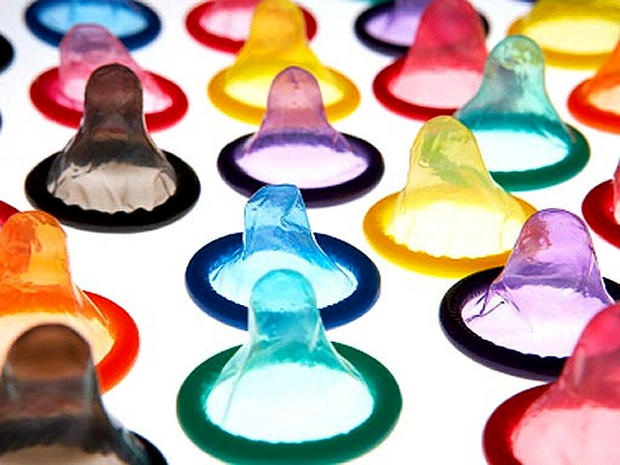CDC report: More teens using condoms but HIV rates problematic in people under 30
(AP) WASHINGTON - Almost half of high school students say they've had sex, yet progress seems to have stalled in getting them to use condoms, government researchers reported Tuesday at the XIX International AIDS Conference.
Today, four of every 10 new HIV infections occur in people younger than 30, according to the Centers for Disease Control and Prevention - and the teen years, just as youths become sexually active, are key for getting across the safe-sex message.
CDC: More teen girls using contraception, waiting longer
U.S. teen pregnancy rates at an all-time low across all ethnicities
Using a long-standing survey of high school students' health, the CDC tracked how teen sexual behavior has changed over 20 years. The results are decidedly mixed.
About 60 percent of sexually active high school students said they used a condom the last time they had sex, the researchers said. That's an increase from the 46 percent who were using condoms in 1991.
"This is good news," said Dr. Kevin Fenton, director of CDC's HIV prevention center. But, "we need to do a lot more."
Condom use among high school students peaked at 63 percent back in 2003.
Black students are most likely to heed the safe-sex message, yet their condom use dropped from a high of 70 percent in 1999 to 65 percent last year, the study found.
Today, 47 percent of high school students say they've had sex, down just a bit from 54 percent in 1991. They typically start at 16, the CDC said. Black teens showed a bigger decrease, with 60 percent sexually active today compared with 82 percent two decades ago.
The more partners, the more risk. Fifteen percent of high school students say they've had four or more partners, down from 19 percent in 1991.
Fenton said part of the problem is that many school systems don't have strong enough sex education policies that include teaching teens about how to prevent HIV. But he cautioned that the CDC study can't link the abstinence-only policies pushed by Congress through the late 1990s and early 2000s to the stalled progress.
Focusing on individual risk behaviors is just part of the story. Increasingly, HIV is an infection of the poor, and specialists at the world's largest AIDS meeting all week are making the point that tackling it globally will require broader efforts to address problems of poverty including better access to overall health services and fighting stigma.
In hard-hit Africa, where 60 percent of infections are among women, U.S. researchers announced a new step to develop tools women can use to protect themselves when their partners won't use condoms. A new study will test a monthly vaginal ring that oozes an anti-AIDS drug into the surrounding tissue in hopes of blocking HIV. The study, funded by the National Institutes of Health, will enroll nearly 3,500 women in Malawi, South Africa, Uganda, Zambia and Zimbabwe.
In the U.S., where new infections have stubbornly held at about 50,000 a year for a decade, complacency is part of the problem, Fenton added.
"We have to generate a new sense of urgency," he said.
Overall, though, a characteristic of the young is to think they're invincible, Fenton added.
Lawrence Stallworth II, 20, of Cleveland can attest that they're not. He learned he was infected with HIV at age 17, when he was a high-school senior, after a hospitalization. A black gay man, he's among one of the nation's highest-risk groups. He's now an Ohio AIDS activist who works to teach young people that they need to protect themselves, and how.
"I want people to have the tools to keep themselves safe," said Stallworth, who at this week's AIDS conference is working with the nonprofit Advocates for Youth to increase young people's awareness of an epidemic that in the U.S., today gets little publicity.
Part of that involves our society getting "better at being more open about being able to talk about sex," Stallworth added. "It's still a taboo issue."
Indeed, at this week's conference, the world's largest AIDS meeting, young gay men are emerging as a population in special danger from rising HIV infections worldwide, and young black gay men especially in the U.S.
Black gay and bisexual men account for 1 in 500 Americans but 1 in 4 new HIV infections. The odds that a black man who has sex becomes infected rise from 1 in 4 at age 25 to a stunning 60 percent by age 40, said Phill Wilson of the Black AIDS Institute.
But they're not the only ones at risk. The CDC recommends that everyone in the U.S. ages 13 to 65 be tested for HIV at least once. Those at increased risk - such as people who have multiple sex partners or men who have sex with men - should be tested more frequently, at least once a year.
In South Carolina, 18-year-old Quinandria Lee offers an example of the safe sex practices that CDC says more young people should adopt.
Lee was frustrated at her school's abstinence-only focus. She learned about both male and female condoms from the South Carolina Contraceptive Campaign, and last year her principal allowed her to teach her classmates about them. Condoms are the only contraceptive that also protect against HIV infection.
But Lee credits her mother's frank talk about sex with this key protective step: Lee persuaded her boyfriend to go with her to a clinic where both got a clean bill of health before they ever had sex. Still, they use a condom every time.
"It's hard," she said of that get-tested conversation. But "you can't be too sure."
